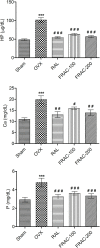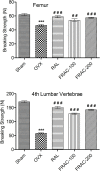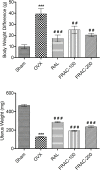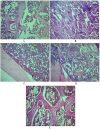A fraction of Pueraria tuberosa extract, rich in antioxidant compounds, alleviates ovariectomized-induced osteoporosis in rats and inhibits growth of breast and ovarian cancer cells
- PMID: 33444328
- PMCID: PMC7808586
- DOI: 10.1371/journal.pone.0240068
A fraction of Pueraria tuberosa extract, rich in antioxidant compounds, alleviates ovariectomized-induced osteoporosis in rats and inhibits growth of breast and ovarian cancer cells
Abstract
Pueraria tuberosa (Roxb. ex Willd.) DC., known as Indian Kudzu belongs to family Fabaceae and it is solicited as "Rasayana" drugs in Ayurveda. In the present study, we analyzed the efficacy of an ethyl acetate fraction from the tuber extract of Pueraria tuberosa (fraction rich in antioxidant compounds, FRAC) against menopausal osteoporosis, and breast and ovarian cancer cells. The FRAC from Pueraria tuberosa was characterized for its phenolic composition (total phenolic and flavonoid amount). Antioxidant property (in vitro assays) of the FRAC was also carried out followed by the analysis of the FRAC for its antiosteoporotic and anticancer potentials. The antiosteoporotic activity of FRAC was investigated in ovariectomy-induced osteoporosis in rats. The cytotoxicity effect was determined in breast and ovarian cancer cells. Gas chromatography/mass spectrometry (GC/MS) analysis of the FRAC was performed to determine its various phytoconstituents. Docking analysis was performed to verify the interaction of bioactive molecules with estrogen receptors (ERs). The FRAC significantly improved various biomechanical and biochemical parameters in a dose-dependent manner in the ovariectomized rats. FRAC also controlled the increased body weight and decreased uterus weight following ovariectomy in rats. Histopathology of the femur demonstrated the restoration of typical bone structure and trabecular width in ovariectomized animals after treatment with FRAC and raloxifene. The FRAC also exhibited in vitro cytotoxicity in the breast (MCF-7 and MDA-MB-231) and ovarian (SKOV-3) cancer cells. Furthermore, genistein and daidzein exhibited a high affinity towards both estrogen receptors (α and β) in the docking study revealing the probable mechanism of the antiosteoporotic activity. GC/MS analysis confirmed the presence of other bioactive molecules such as stigmasterol, β-sitosterol, and stigmasta-3,5-dien-7-one. The FRAC from Pueraria tuberosa has potential for treatment of menopausal osteoporosis. Also, the FRAC possesses anticancer activity.
Conflict of interest statement
The authors have declared that no competing interests exist.
Figures










Similar articles
-
Pueraria tuberosa: A Review on Traditional Uses, Pharmacology, and Phytochemistry.Front Pharmacol. 2021 Jan 27;11:582506. doi: 10.3389/fphar.2020.582506. eCollection 2020. Front Pharmacol. 2021. PMID: 33708108 Free PMC article. Review.
-
Antioxidant and Antiapoptotic effect of aqueous extract of Pueraria tuberosa (Roxb. Ex Willd.) DC. On streptozotocin-induced diabetic nephropathy in rats.BMC Complement Altern Med. 2018 May 11;18(1):156. doi: 10.1186/s12906-018-2221-x. BMC Complement Altern Med. 2018. PMID: 29751837 Free PMC article.
-
Antioxidant and anticancer activities of green synthesized silver nanoparticles using aqueous extract of tubers of Pueraria tuberosa.Artif Cells Nanomed Biotechnol. 2018;46(sup3):S71-S85. doi: 10.1080/21691401.2018.1489265. Epub 2018 Jul 25. Artif Cells Nanomed Biotechnol. 2018. PMID: 30043665
-
An ethnopharmacological approach to evaluate antiparasitic and health-promoting abilities of Pueraria tuberosa (Willd.) DC. in livestock.PLoS One. 2024 Jul 19;19(7):e0305667. doi: 10.1371/journal.pone.0305667. eCollection 2024. PLoS One. 2024. PMID: 39028725 Free PMC article.
-
Pueraria tuberosa: a review on its phytochemical and therapeutic potential.Nat Prod Res. 2014;28(23):2111-27. doi: 10.1080/14786419.2014.928291. Epub 2014 Jul 1. Nat Prod Res. 2014. PMID: 24980468 Review.
Cited by
-
Unraveling the anti-breast cancer activity of Cimicifugae rhizoma using biological network pathways and molecular dynamics simulation.Mol Divers. 2025 Feb;29(1):241-254. doi: 10.1007/s11030-024-10847-3. Epub 2024 Apr 13. Mol Divers. 2025. PMID: 38615110
-
Pueraria lobata Targeted Preparation Improves the Clinical Symptoms of Cervical Spondylosis by Regulating the Balance of Gut Microbiota.Comput Math Methods Med. 2022 Jan 27;2022:2136807. doi: 10.1155/2022/2136807. eCollection 2022. Comput Math Methods Med. 2022. Retraction in: Comput Math Methods Med. 2023 Oct 18;2023:9807674. doi: 10.1155/2023/9807674. PMID: 35126618 Free PMC article. Retracted. Clinical Trial.
-
Pueraria tuberosa: A Review on Traditional Uses, Pharmacology, and Phytochemistry.Front Pharmacol. 2021 Jan 27;11:582506. doi: 10.3389/fphar.2020.582506. eCollection 2020. Front Pharmacol. 2021. PMID: 33708108 Free PMC article. Review.
-
Daidzein and Genistein: Natural Phytoestrogens with Potential Applications in Hormone Replacement Therapy.Int J Mol Sci. 2025 Jul 20;26(14):6973. doi: 10.3390/ijms26146973. Int J Mol Sci. 2025. PMID: 40725220 Free PMC article. Review.
-
Studies on Chemical Composition of Pueraria lobata and Its Anti-Tumor Mechanism.Molecules. 2022 Oct 26;27(21):7253. doi: 10.3390/molecules27217253. Molecules. 2022. PMID: 36364084 Free PMC article.
References
-
- WHO. Scientific Group on the Assessment of Osteoporosis at Primary Health Care Level. Summary Meeting Report. Geneva: World Health Organization. 2007 [Accessed March 2, 2020]. Available at www.who.int/chp/topics/Osteoporosis.pdf.
Publication types
MeSH terms
Substances
LinkOut - more resources
Full Text Sources
Other Literature Sources
Medical
Miscellaneous

